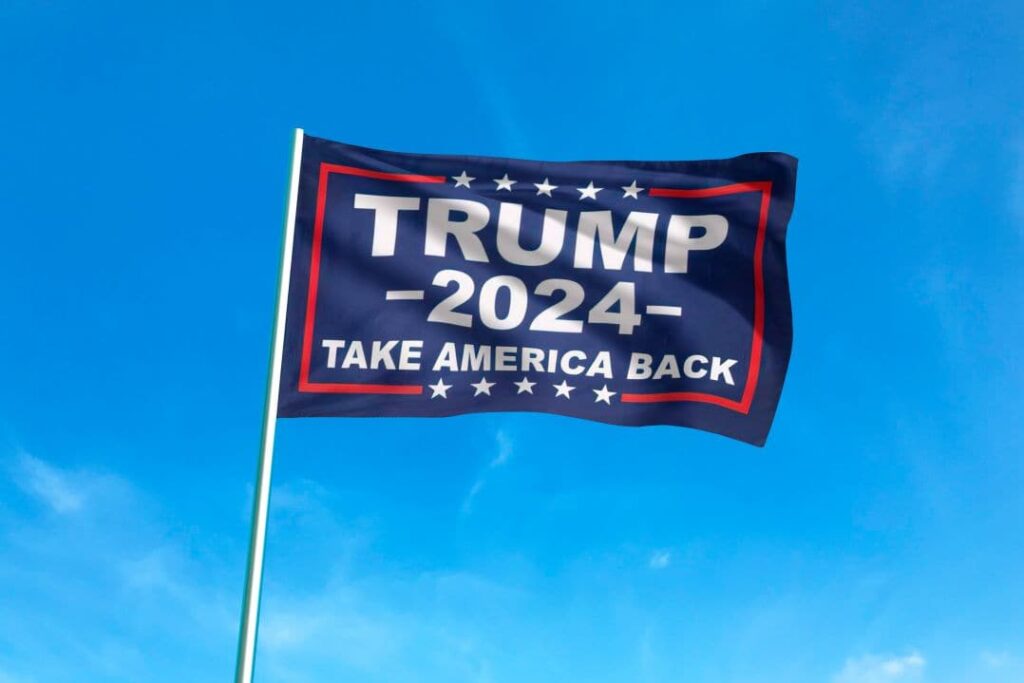In the dynamic arena of American politics, symbols reign supreme. They serve as rallying cries, embodiments of ideologies, and markers of identity. Among the myriad symbols that have emerged in recent years, few have commanded as much attention and controversy as the Trump flag. Bearing the name and image of former President Donald Trump, this emblem has become emblematic of a movement that continues to shape the political landscape of the United States. As the nation gears up for the pivotal 2024 election, the significance of the Trump flag looms large, offering insight into the nation’s ideological divides, cultural shifts, and the enduring legacy of Trump’s presidency.
The Rise of the Trump Flag
The Trump flag first gained prominence during Donald Trump’s unprecedented ascent to the presidency in 2016. Emblazoned with variations of his slogan “Make America Great Again” (MAGA), alongside images of Trump’s visage, the flag quickly became a ubiquitous sight at campaign rallies, political events, and even suburban neighborhoods across the country. Its bold colors and uncompromising message captured the fervor of Trump’s base, signaling a departure from conventional politics and a rallying cry for those disillusioned with the status quo.
Symbolism and Significance
At its core, the Trump flag represents more than just support for a particular candidate or political party. It encapsulates a set of ideals and beliefs that resonate deeply with millions of Americans. For some, it symbolizes a rejection of political correctness and a desire to restore traditional values. For others, it signifies a commitment to economic nationalism and an America-first agenda. Still, for many, it embodies a sense of grievance and resentment towards perceived elites and the establishment.
Moreover, the Trump flag has transcended its political origins to become a cultural touchstone. It symbolizes a sense of belonging to a distinct community, forged around shared values and a common enemy – the so-called liberal elite. Displaying the flag has become an act of defiance, a statement of identity, and a declaration of allegiance to a movement that transcends traditional party lines.
Political Implications
As the 2024 election looms on the horizon, the Trump flag remains a potent force in American politics. Its presence serves as a litmus test for candidates seeking to harness the support of Trump’s base. Those who align themselves with Trump’s brand of populism and nationalism often find themselves flying the flag proudly, while others tread more cautiously, wary of alienating moderate voters.
The significance of the Trump flag extends beyond mere symbolism. It serves as a barometer of public sentiment, indicating the strength of Trump’s influence within the Republican Party and the broader conservative movement. Candidates vying for the party’s nomination must navigate the delicate balance between appealing to Trump’s loyal base and appealing to the broader electorate.
Societal Divisions and Cultural Shifts
Perhaps more than anything else, the Trump flag reflects and perpetuates the deep societal divisions that have come to define American politics in the 21st century. Its presence evokes strong reactions, sparking heated debates and fueling tensions between opposing factions. Supporters see it as a badge of honor, a symbol of resistance against perceived encroachments on their way of life. Detractors, meanwhile, view it as a symbol of bigotry, intolerance, and regressive politics.
The polarization surrounding the Trump flag is emblematic of larger cultural shifts taking place within American society. It speaks to a growing sense of tribalism and identity politics, where loyalty to a particular leader or movement takes precedence over reasoned discourse and compromise. The rise of social media and digital echo chambers has only served to exacerbate these divisions, amplifying voices on both sides of the political spectrum and further entrenching partisan divides.
Looking Ahead
As the 2024 election approaches, the significance of the Trump flag shows no signs of waning. If anything, its influence may continue to grow as the Republican Party grapples with its identity in the post-Trump era. Whether it serves as a unifying symbol for a fractured party or a divisive wedge driving deeper wedges between competing factions remains to be seen.
Regardless of its electoral implications, the Trump flag will undoubtedly leave a lasting imprint on American politics and society as a whole. It serves as a stark reminder of the power of symbols to shape our perceptions, our beliefs, and our collective destiny. In an era defined by uncertainty and upheaval, the Trump flag stands as a testament to the enduring power of political symbolism in the realm of American politics.







